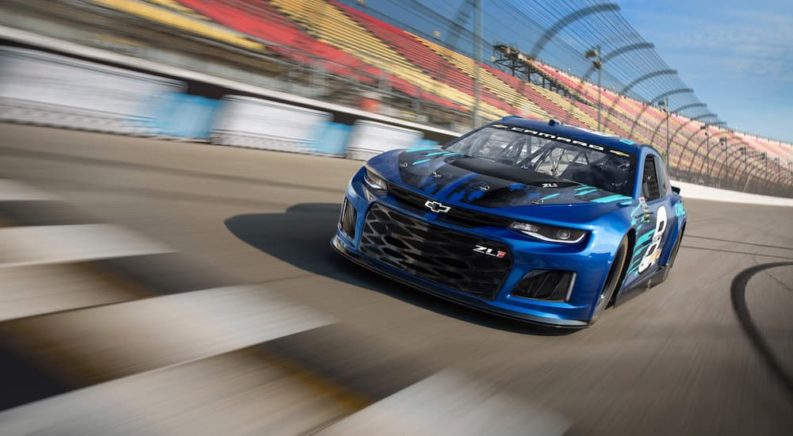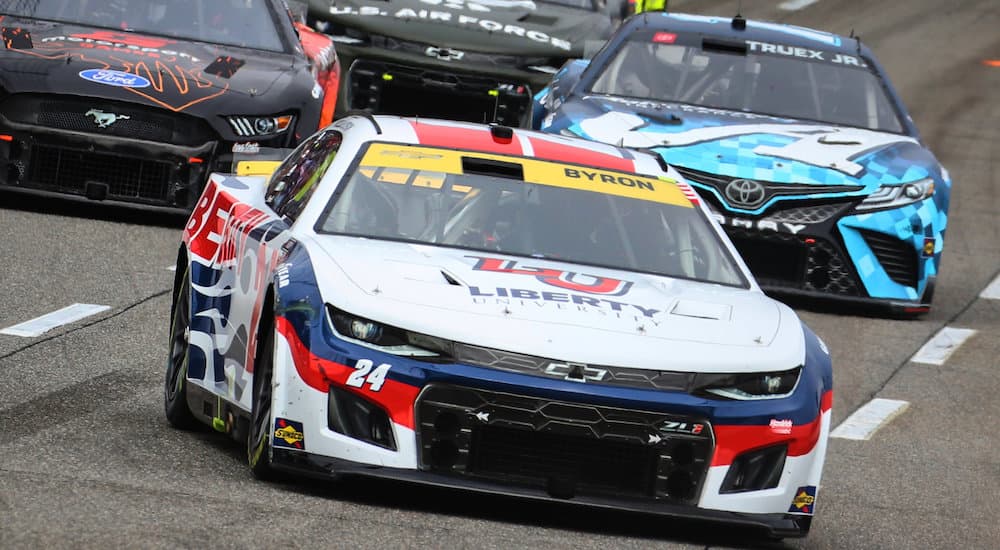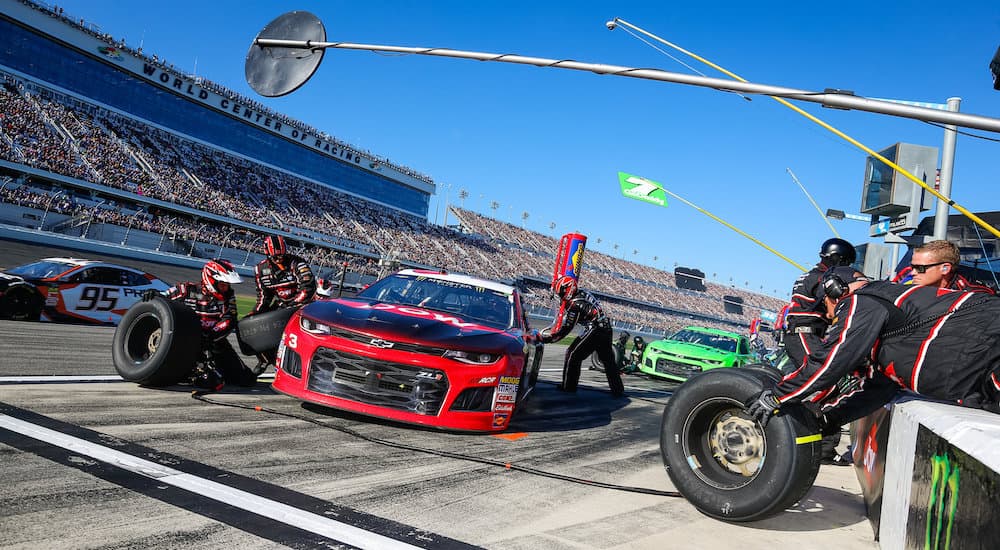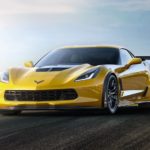The 2022 NASCAR season has seen the debut of the new Next Gen car for the Cup Series, but the switch to a new car hasn’t slowed down the winningest manufacturer in NASCAR history. Chevy celebrated the new NASCAR Camaro ZL1 by picking up 18 wins in the regular season––more than twice as many as Ford back in the number two position. As the Nex Gen Camaro ZL1 kicks off the latest generation of stock car racing, it is time to look back at the great Chevy race cars of the past and the era when “win on Sunday, sell on Monday” led drivers to flock to their Chevy dealer to drive off in the same cars that made Chevy a NASCAR legend.
The Chevy Bel Air Breaks Ground in 1955
NASCAR traces its history back to 1949 when the Strictly Stock series launched (it would be renamed the Grand National the very next year). Back in those days, stock cars couldn’t have any modifications, and you could go straight from the dealership lot to the podium. However, Chevy wasn’t a big player in those early races––the big GM brand of the day was Oldsmobile. It wasn’t until 1955, when Fonty Flock drove a Chevy Bel Air across the finish line at Columbia Raceway, that the Bowtie brand scored its first NASCAR win. After that first win, the race was on, and Chevy began racking up podium finishes and manufacturer’s championships.
The 1955 Bel Air marked the first year of this iconic model’s second generation, and Chevy had spiced things up by adding a brand-new 265 cubic inch small-block V8 engine. Choosing the optional Power Pack added a four-barrel carburetor and upped engine output to a whopping (for the time) 180 hp. While the Chevy name is now synonymous with powerful V8 engines, this was actually the first time that Chevy had offered a V8 in its cars, which could help explain the brand’s previous lack of NASCAR success.
The 1958 Chevy Impala Takes the Lead
In 1958, the Chevy Bel Air Impala debuted as the top-of-the-line version of Chevy’s full-size car and found instant success in NASCAR. The 1958 Grand National season saw Chevy pick up its very first manufacturer’s championship, and Buck Baker came in second for the driver’s championship behind the wheel of an Impala. This was the beginning of Chevy’s dominance of both the NASCAR circuit and the muscle car era.
The secret behind the success of the 1958 Impala was, unsurprisingly, a new V8 engine. Displacing 348 cubic inches, the “Special Super Turbo-Thrust” big-block was a dedicated race engine with solid lifters, three two-barrel carburetors, and an impressive 315 hp. There were also more tame “Super Turbo-Thrust” and “Turbo-Thrust” versions producing 305 and 280 hp available on Chevy dealer lots for mere mortals. Combined with the added rigidity from the new X-frame construction, the 1958 Impala was an instant success.
Chevy Returns With the 1972 Monte Carlo
After winning four consecutive manufacturer’s titles from 1958 to 1961, Chevy took a backseat to Ford for a full decade. However, the bowtie brand returned with a vengeance in 1972. In that year, Bobby Allison switched from Ford to Chevy and won ten races from behind the wheel of a midsize Monte Carlo. NASCAR had changed the rules in 1967, allowing the use of midsize cars, which reflected the changing lineup available at Chevy dealers across the country. But while smaller cars were in, engines kept getting bigger.
The Monte Carlo had been introduced two years earlier, in 1970, and was part of the new “personal luxury” segment. The high-performance version came with a 454 cubic inch “Turbo-Jet” V8 engine paired with a four-speed manual transmission. Originally, this engine was rated for 360 hp, but the switch to unleaded gasoline and SAE net horsepower ratings meant the 1972 version was only rated for 270 hp. The NASCAR versions of the car were not stock, usually sporting a modified frame and powertrain, which had been made legal as part of the rules changes.
The 1983 Monte Carlo, Smaller and Faster
From 1972 to 1980, Chevy had an almost unbroken record of manufacturer’s championships, only giving up the 1975 season. However, NASCAR changed the rules again in 1981, introducing the smaller Generation 3 cars. These vehicles were designed to follow the trend of smaller vehicles appearing at dealerships, but the versions found on the track were more modified than ever. Buick picked up the first two manufacturer’s championships after the rules changed, but Chevy was back on top for the 1983 season, with the downsized fourth-generation Monte Carlo leading the way.
The 1983 Monte Carlo SS lived in the shadow of the closely-related Buick Grand National, but it was a high-performance car in its own right. It was the first SS version of this long-time NASCAR favorite since 1971, and the street version homologated a more aerodynamic nose for racing use. Under the hood was a 305 cubic inch V8 engine rated for an admittedly disappointing 175 hp. This was the car that launched Dale Earnhardt’s legendary NASCAR career and kept Chevy at the head of the manufacturer’s standings.
The Aerodynamic 1989 Lumina
One of the more controversial cars in Chevy’s NASCAR history was the Lumina. Introduced on the track for 1989, a year before it was available at Chevy dealerships, the Lumina was a sign of NASCAR’s move away from its origins in true stock car racing. The street version of the Lumina was available as either a four-door or a two-door, but the NASCAR version was, of course, based on the two-door. More importantly, the street version was only available with a 3.4L V6 engine, while the race car had a 5.7L V8.
Compared to the Monte Carlo, the Lumina was more aerodynamic, an attribute that was becoming increasingly important as NASCAR introduced restrictor plates in 1988 in order to reduce engine power and improve safety. Aerodynamics took another jump forward for the 1992 season when NASCAR allowed teams to begin using heavily modified body panels for the Generation 4 cars. However, this spelled the death of the Lumina as Chevy returned to a more aerodynamic Monte Carlo for 1995.
The Impala Returns for 2008
In 2007, NASCAR introduced the Car of Tomorrow. This marked the completion of the transition from stock cars that you could buy off the dealership lot to purpose-built race cars that bore only a passing resemblance to their road-going counterparts. In 2007, Chevy also discontinued the Monte Carlo. This meant that teams entered the 2008 series in the Impala SS, the first time the Impala name had appeared in NASCAR since the 1960s.
The road-going version didn’t have a single part in common with the race car that shared its name, but the 2008 Impala SS was a sleeper of a performance car. Despite being front-wheel drive, it boasted a 5.3L V8 engine with 303 hp. Unfortunately, the SS trim was discontinued in 2009, leaving a 3.9L V6 as the top engine. The Impala SS retired from NASCAR in 2012, with the shift to the Generation 6 car.
The Camaro Appears in 2018
After running the simply named Chevy SS from 2013 to 2018 (despite only offering this V8 sedan at Chevy dealers from 2014 to 2017), Chevy introduced the Camaro ZL1 to NASCAR in 2018. It may seem surprising to learn that Chevy’s premier muscle car was such a latecomer to racing, but NASCAR was originally intended to showcase the larger sedans that once dominated American roads rather than small sports cars. However, as powerful sedans fell out of favor and the car-buying public turned to SUVs and pickup trucks, manufacturers like Chevy were left with few models that would make sense for NASCAR.
The Camaro Is Gaining Success
Disappointingly, the introduction of a legend like the Camaro was not met with instant success. In fact, Chevy did not win a manufacturer’s championship from 2016 through 2020. However, the Camaro ZL1 helped Chevy take first place in 2021, and the results during the 2022 regular season suggest the bowtie brand might be back on track with the Next Gen car. For now, it looks like the Camaro will represent Chevy well in the coming years, but who knows what model will be the next Chevy NASCAR legend?






